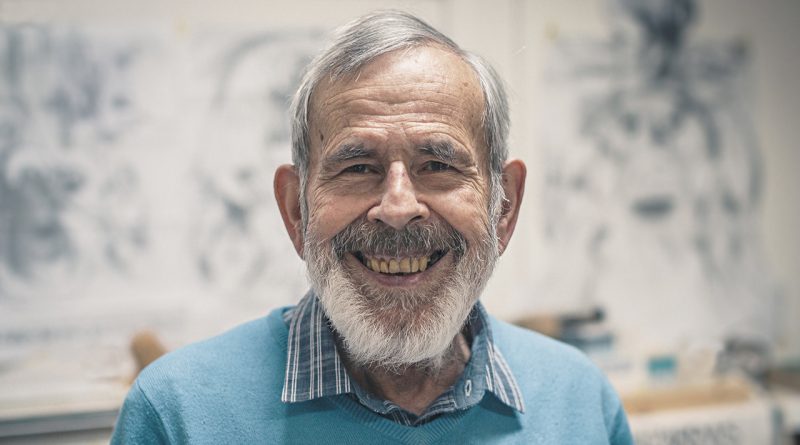David John: death of leading UK Catholic sculptor who was inspired by St John the Baptist
Tributes have been paid to a leading Catholic sculptor who has died.
David Anthony John was born in Port au Prince, Haiti in 1928, the son of Basil Joseph John, a manager for Shell in the West Indies, and Anita Rosalys John (neé Burns).
He was sent to school at Hodder Place, prep school to Stonyhurst College, but left England in 1939, sailing on one of the last passenger boats to cross the Atlantic before the outbreak of World War II.
During the war he studied drawing in Jamaica with the artist and sculptor Edna Manley. Arriving back in England in 1946, he studied painting in Birmingham under Bernard Fleetwood-Walker.
Moving to London in 1948, he became an apprentice woodcarver to Anton Dupré of Burns & Oates, and between 1950 and 1952 he was taught stone cutting and lettering by Freda Skinner, head of sculpture at Wimbledon School of Art.
He met the artist Marianne Hellwig, who had arrived in England in 1939 as a refugee from Nazi Germany.
They married in 1952 and, as well as producing six children, became lifetime artistic collaborators.
In 1953 he set up a workshop in Bucklebury, Berkshire where, after a few years, he was able work on his first major commissions for the notable Liverpool architect F. X. Velarde, for integral sculpture and furnishings at the Votive Shrine of Our Lady of Lourdes, Blackpool, built in 1955-7 as a thank offering for the Diocese of Lancaster’s relative escape from wartime bomb damage, followed in 1958 by further stone sculptural group and internal furnishings at St Luke.
In the same year he produced a bronze Madonna (‘Our Lady of Liverpool’) for the crypt of Lutyens’ Liverpool Metropolitan Cathedral.
The following decades saw a steady stream of commissions, numbering as many as 900 in total.
“It’s feelings that I relate to, I suppose, John once said in an interview with makeaplace.com.
“Teaching, communicating, and having faith with a strong element of narrative. A painting that I did when I was a boy I’ve since translated into John the Baptist. He was an extraordinary figure, living on almost nothing and, in a way, I’m sort of dedicating and honouring this man. He was clearly in another world. It was all based on a memory. A memory of this man because we used to see him in the market.”
His broad training and ability to work in different materials including resin, stone and wood resulted in high demand for altars, fonts, tabernacles, stations of the cross, holy water stoups.
Whatever the medium, his work was figurative, bold in conception and finely executed.
Most commissions were for the Catholic Church in England and Wales, but there was also a stream of Anglican, secular and overseas work. Over the years he worked with many highly talented assistants including; Chris Lane, Michael Holyfield, John Worton and Danny McCue.
David John was not a great self-publicist and outside Catholic architectural and artistic circles he was not well known; however, he was at the heart of developments, and few matched him in sheer productivity.
“I’m a sculptor and I also design the layout in churches,” he said.
“Nothing must be superfluous. It must be necessary. I was working on a church and one of the people there said: ‘My daughter’s getting married next year and I don’t like to see just an ordinary chair being used—would you be interested in doing marriage chairs?’ And I said, yes.”
In 1974 David John spent two months travelling around Europe having been awarded a Churchill Fellowship, exploring and painting watercolours while touring around post-war church architecture.
His last commission was for the stations of the cross at Our Lady of Lourdes, Wanstead, East London, installed in 2017.
Carved by David and painted by Marianne, they were produced in his late eighties, yet show no diminution in vigour and creativity.
David John was a gentle and compassionate man, with a mischievous sense of humour. The family home was always open to friends, family and those passing through in need of a meal or bed for the night.
“There was something unparalleled and inimitable in his gentle warmth,” said Stroud News reporter James Felton.
“Meeting him was like approaching a softly glowing fireplace. He. was so welcoming, pleased to see one, interested, concerned. I met him only intermittently, on ’family’ occasions, but he was the person I would, on arrival, look for in the room, because he was such a pleasure to be with.”
He was active in the peace movement, Pax Christi and the Campaign for Nuclear Disarmament.
He served as an Independent parish and district councillor after moving to Berkshire in 1959.
After a further move to Gloucestershire in the late 1980s he became active in the local Labour party for over 30 years.
Alongside Marianne he took part in many Open Studio Exhibitions.
David died at More Hall, Randwick, on 26th August, aged 95.

